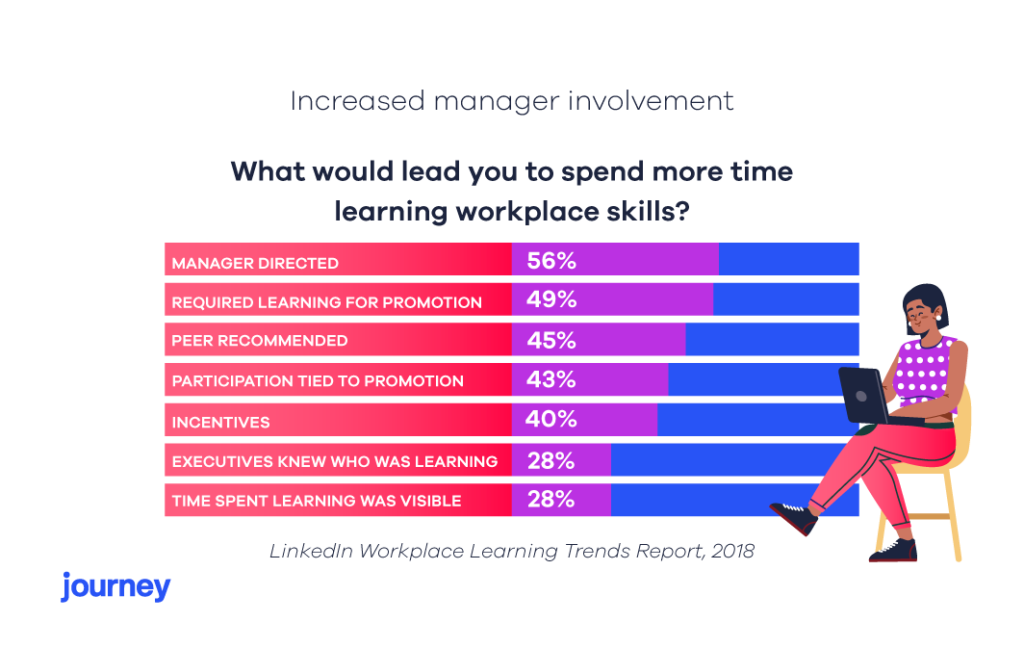Technology adoption and the impacts of the pandemic have been changing the world of work. The World Economic Forum predicts 1.2 billion employees worldwide will be affected by the adaptation of automation technologies, digitization, and AI over the next ten years. Building up skills of the future is key to business success.
HR leaders know that technological change will require their employees to acquire more skills. They also know that recruitment “in the age of skill shortages” and the supply from higher education will be insufficient. So firms will have to upskill or reskill employees themselves.
Managers who know their direct reports best matter a great deal in people development. According to a LinkedIn study, “manager direction” is the biggest motivator for employees to develop themselves. 56% of employees say that they would spend more time learning and developing if their manager directed them to improve their skills. Yet, improving people at work is too often left to the rote box-checking of annual performance reviews.

As professors Ibarra and Scoular notes, “The role of a manager, in short, is becoming that of a coach.” So, how can managers grow their employees? We have compiled the best practices HR leaders and managers can use to develop their employees.
Start by Identifying Must-haves
First, ask these questions:
-
- What are the business-critical development areas for your company and the employee?
-
- What “new skills” does the employee need (i.e., data analytics skills for an HR role or digital marketing automation for a marketing role)?
-
- Are there any gaps in your employee’s current knowledge or experience?
-
- What carries the biggest risk or the biggest gain?
Identifying the most business-critical development area is a crucial success factor in people development. Tugrul Turkkan, founder of Journey app -a people development software- says, “Like a button on a shirt buttoned wrong, do not let the development journey start with something that you would sacrifice for ‘real work.'”
Create Development Plans
After you decide what is business-critical in your setting, you should schedule development 1:1s with your employees. Work together to build an IDP (individual development plan) that includes specific skills and personal growth components. While creating an IDP for each employee, take these into account:
-
-
Set development goals and develop one topic at a time. Do not overload.
-
An IDP starts with a business-critical development goal. Studies indicate setting one development goal is more effective. “The more focused employees’ career goals, the more likely they will be to engage in behaviors that will help them reach their goals and the greater their motivation to participate in development activities.” The Journey app limits managers to selecting only one development area every three months. The immediate focus is always one topic at a time. No overload.
Also, keep in mind that the employee must communicate her/his aspirations and find them in the goals. So, make sure you create the plan together with your employee.
Then, work on development activities that support the employee to reach this goal.
-
-
Give on-the-job assignments
-
Studies reveal that working on job-related tasks and problems is by far the most effective development method. And development is about only 10% from training and content. Most online learning and development solutions are content-driven, a library of e-courses, videos, and articles. Researchers Lombardo and Eichinger asked executives how they believed they learned. According to the survey, “the odds are that development will be about 70% from on-the-job experiences – working on tasks and problems; about 20% from feedback and working around good and bad examples of the need; and 10% from courses and reading.” So, prioritize on-the-job assignments in your development plan to ensure that the employees develop while “doing.”
-
-
Encourage Peer-to-Peer Development (mentors/coaches)
-
The best professional development cultures put mentorship and coaching into their professional development mix. “A blended mentoring-coaching culture supports individual, team, and organizational development and performance. The key characteristics of a mentoring-coaching culture include respectful communication, a spirit of inquiry (i.e., asking questions), a focus on strengths and learning, and mutual, collaborative problem-solving.” Coach/mentors should bear in mind that their primary role is to help and encourage their learners to develop. The employees should feel comfortable in the relationship with their coaches or mentors to ask the right questions.
Make ongoing development conversations
One of the biggest challenges of development conversations is that they are too infrequent. As one interviewee noted in our pilots, “This happens every time. We complete an IDP form with my manager. A year passes. And I realize, just before our review, that I (and my manager, of course) totally forget what we are developing.” Development requires actionable guidance and continuous follow-up. In our pilots, we tried annually, bi-annually, quarterly, and monthly development 1:1s. Quarterly development conversations have become the most effective one: not too far away to forget development and not time-consuming to give away.
Provide constructive developmental feedback
As a manager, you provide your employees with opportunities to grow, but to reflect on their progress, they also need honest and encouraging feedback. So, how can you do that? According to Harold Koontz and Heinz Weihrich, “to elicit honest feedback, a manager should develop an atmosphere of trust and confidence and a supportive leadership style, with a de-emphasis on status (such as barricading oneself behind an extra-wide executive desk). Separate developmental feedback or coaching from performance appraisal feedback or judging. And developmental feedback can either be destructive or constructive.
Destructive feedback is feedback that disapproves without any intention of being helpful and almost always causes a negative or defensive reaction in the recipient. On the other hand, constructive feedback is a feedback intended to be helpful, corrective, and encouraging. It is essential to stay on the constructive side if your goal is to develop your employees. It doesn’t hurt to know that millennials request feedback 50% more often than other employees.
Follow up
As a manager, it is also essential to do regular follow-ups if you want to see effective development. As one interviewee noted, “When I return to my desk and think, if I can get the work done my manager wants and if she is not reinforcing things, then why change my behavior?”
Monitor and evaluate progress
Last but not least, monitor and evaluate progress. At the end of each quarter, Journey asks both the manager and the employee to assess the outcomes. The manager evaluates if there is any improvement in the selected business-critical skill. The employee evaluates whether the development activities such as stretch assignments, mentors, training, or the support from the manager positively affected her/his development or not. HR teams and managers can track simple yet effective metrics such as readiness scores or manager development index, just like marketing teams track NPS.
No matter how big or small, any company can benefit from helping its employees grow professionally and personally. These best practices are there to help you start your journey of growth with your employees.
If you want to learn more about employee development, you can check out our blog posts here.

